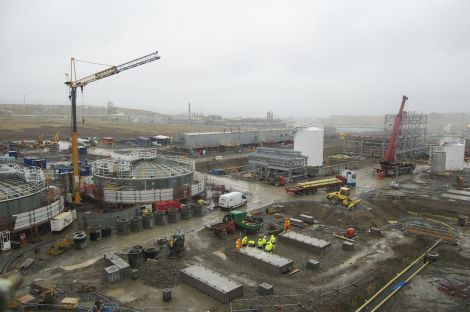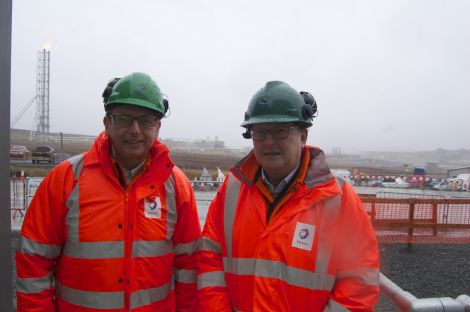News / Gas plant takes shape as costs go up
THE BIGGEST gas development in Britain is on target to start production next year, but costs have increased by one third due to rising prices and unforeseen challenges.
French energy giant Total said that when the Shetland Gas Plant opens in the summer of 2014, it would be the start of a major hub bringing gas ashore from several fields in the north Atlantic for decades to come.
The company is moving at speed with the project, which commenced three years ago with a road being laid across peat moorland to reach the secluded site next to the BP-operated Sullom Voe oil terminal in Shetland’s north mainland.
The workforce has already mushroomed this year from 400 to more than 800 and will peak in four months with around 1,400 employees on site for the rest of the year.
A second 217 bed flotel will be arriving in the isles at the end of June to accommodate extra staff alongside an identical barge already berthed in Lerwick harbour.
In addition employees are being hosted in an 850 bed block at Sella Ness and shortly the 100 bed Moorfield Hotel will open in Brae to take even more staff.
However the project’s costs have shot up, with the entire development now estimated at £3.3 billion, up from £2.5 billion when it began. The cost of the onshore gas plant alone has risen from £500 million to £800 million.
Project director Robert Faulds said that the 500 kilometres of pipework involved in the project would be laid within two months.
Subsea production modules have already been laid 600 metres deep at the Laggan/Tormore field, 143 kilometres west of Shetland, leaving the gas plant as the final phase of the construction to complete.
Faulds blamed the rising cost of materials for the extra expense. “You can spend more money and stay on target or you can spend less money and wait for prices to come down,” he said.
Become a member of Shetland News
However Total’s UK managing director Phillipe Guys suggested that unexpected challenges had played their part too.
“We didn’t expect to have to dig so deep to reach hard rock so we had to do more civil engineering than we thought,” Guys said.
“We also had some very long periods of vessels waiting offshore because of the weather during the winter, which cost £200,000 a day.”
During a tour of the plant on Monday, senior Total management said that they believed west of Shetland would be the company’s third major province.
Alwyn North started operating in 1987 and has maintained production levels of around 140 million barrels of oil equivalent per day (boe/d) since then by tying in seven neighbouring fields with an eighth being drilled at the moment.
The Elgin/Franklin gas field opened in 2001 and has grown into a similar hub pumping gas to St Fergus from several neighbouring fields.
Last year’s Elgin gas leak had been a major blow, reducing output by around one third with production only restarting on 9 March this year, three days after it was passed as safe by the Health and Safety Executive.
The final report on that leak is due to come out in three weeks, but on Monday the company said the cause had been a combination of “stress corrosion cracking” and an unexpected gas release from a hidden formation in the chalk seabed.
Total upstream president Yves Louis Darricarrere said west of Shetland had the prospect of becoming a third hub with gas being tied in from the Edradour field in 2016, and more coming from Glenlivet and Tobermory nearby.
“I am extremely confident that this will become a hub as Alwyn and Elgin is – we are starting a hub. There are not so many players that have these success stories,” Darricarrere said.
The company continues to focus on exploration in the three regions, having purchased nine exploration licences during the most recent bidding round, making it the largest producer in the UK.
There will also be some collaboration at Sullom Voe with their BP neighbours. Even though plans to share a power station came to naught, Total intends to export condensates taken out of the gas that comes ashore to BP, compressing the rest before sending it to Scotland.
Safety remains a prime consideration with the 20mph speed limit on the road to the plant being strictly enforced along with all safety regulations.
Faulds denied there was any truth to rumours that there had been a high turnover of staff due to breaches of their strict safety rules, saying the company preferred to work with and educate employees rather than get rid of them.
However he did admit that some had lost their jobs due to anti social behaviour, as the company strives to remain a good neighbour in the islands.
He said the company employed 100 local people on site, and he was proud they were putting 15 islanders through OPITO apprenticeships to become oil and gas technicians at a cost of £250,000 per person per year.
Once it starts producing 500 million cubic feet of gas per day the plant will employ 80 people full time, all of whom are likely to be resident on the isles.
However he said they would have liked to have contracted more local firms on the construction site.
“I wouldn’t say we have been as successful as we wanted to be with local businesses, but we have a lot of local businesses contracted and they have all been working on an economic basis,” he said.
By the end of its lifetime the plant should have pumped £185 million into the Shetland economy, he added, leaving behind the Moorfield Hotel to boost the tourist trade.
How long the plant remains operational remains open to question, as Faulds repeated: “This is a hub for the future…we believe there will be a continual investment in this hub and the Shetland gas plant will be key to our future for a long time.”
Become a member of Shetland News
Shetland News is asking its many readers to consider paying for membership to get additional features and services: -
- Remove non-local ads;
- Bookmark posts to read later;
- Exclusive curated weekly newsletter;
- Hide membership messages;
- Comments open for discussion.
If you appreciate what we do and feel strongly about impartial local journalism, then please become a member of Shetland News by either making a single payment, or setting up a monthly, quarterly or yearly subscription.




























































